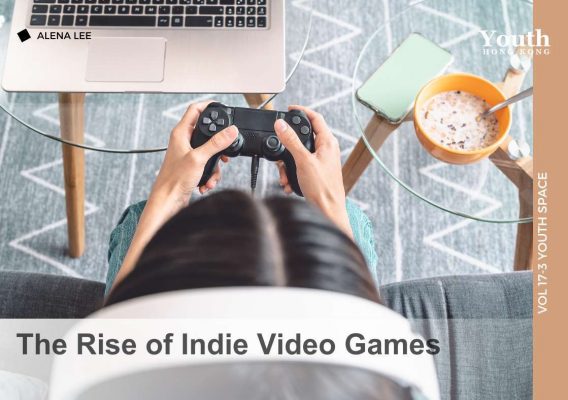by Alena Lee
Alena reflects on her passion for indie games and the creativity that sets them apart from mainstream productions.
Growing up, I often watched my brother play video games, such as Resident Evil, Overwatch, and Red Dead Redemption. Gaming was a pivotal part of my childhood. Not only did it immerse me in thrilling virtual worlds, but it also brought my brother and me closer, since we would never get bored of our video game discussions.
As someone who spends most of their spare time gaming, I have learnt valuable problem-solving skills, particularly from story-driven games that challenge me to think critically and solve conflicts. Gaming also serves as a powerful stress reliever, through which I take a break from academic pressures and feel a sense of accomplishment.
Among all the video games I play, my all-time favourites are independent games developed by individuals or smaller teams, without the backing of major publishers. You may be familiar with independent music and films, but independent games, or “indie games,” are gaining wider recognition. Their popularity has grown rapidly thanks to YouTube, where creators like Markiplier and Kubz Scouts showcase these hidden gems on their channels.
If you share the same taste, you’ve probably heard of the well-known indie game Minecraft. Released in 2009, it’s an open-world sandbox game that gives players the freedom to build and explore without limits. While I never played much Minecraft growing up, I definitely noticed its impact on the gaming community. I believe that despite its simple concept of building blocks and exploration, the game gives players a sense of freedom, providing a platform for self-expression through creativity, for example, by building a village and expanding it. This allows players to create unique worlds that reflect their tastes and identities, allowing them to express who they are.
Additionally, Minecraft teaches players resource management. In survival mode, they must carefully manage their resources, understand inventory management and prioritisation. This game has also propelled many YouTubers to fame, including Dream and Technoblade. Its cultural impact is undeniable. The game was even expanded into a blockbuster film in 2025 that became one of the highest-grossing video game adaptations ever, with a global box office of $955.1 million US dollars.
However, the game that resonates with me the most is the thrilling mascot horror game, Five Nights at Freddy’s, commonly abbreviated as FNAF. Created by American video game developer Scott Cawthon, the game has successfully expanded into a series, featuring approximately 30 games, 58 books and one movie to date. I fell in love with the deep lore and secrets in these games that tell a very compelling story, leaving viewers wanting more.
Those timeless indie games have shaped the modern indie game landscape and inspired a wave of new games.
One recent example is Fears to Fathom, an episodic interactive experience that immerses players in horrifying, relatable real-life situations through captivating narration. Its blend of survival horror and dialogue-driven narrative, combining a retro aesthetic from the 1990s, is so appealing in the current era of indie games because it attracts both the older and younger generations. Many people who grew up with games released in the late 90s to early 00s have fond memories of those classic games. Their modern adaptations evoke a sense of nostalgia when reliving those experiences. The younger generation often plays mainstream games with high-definition graphics, and the retro style feels fresh to them, allowing them to appreciate the evolution of video game graphics.
So, what exactly sets indie games apart from mainstream ones? To start off, most mainstream games typically focus on high-quality graphics, numerous mechanics and large-scale maps. In contrast, indie games usually prioritise narrative and artistic expression. With smaller budgets and teams, indie developers focus on creating meaningful experiences rather than relying on visual spectacle.
But graphics isn’t the only factor. Indie game developers often engage more closely with their communities and are more aware of the feedback from players. This is because the implementation of changes in mainstream games requires longer development cycles, making it harder to incorporate community feedback swiftly. As a result, indie game developers have more creative control over their games, which allows for experimental gameplay. As indie games are self-funded, developers are less beholden to publisher demands and market pressures. However, large-scale development teams in mainstream studios may struggle to preserve the vision of individual creators.
In my opinion, the future holds great promise for indie games. We are seeing more and more games achieving commercial success, and in some instances, collaborating with large corporations to expand their games into full-fledged franchises.
Beyond the promise of success and thrill of playing, indie games remind me that you don’t need a massive budget to create something extraordinary. With passion, creativity, and community support, a small team — or even a single developer — can change the game. ■
 Alena Lee is a Secondary 3 student at HKFYG Lee Shau Kee College and a member of the school’s editorial team. Having participated in the Young Historian Training Program 2023-2024, she enjoys exploring historical topics and the history of video games.
Alena Lee is a Secondary 3 student at HKFYG Lee Shau Kee College and a member of the school’s editorial team. Having participated in the Young Historian Training Program 2023-2024, she enjoys exploring historical topics and the history of video games.


